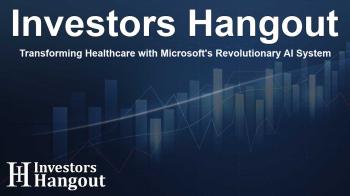Transforming Healthcare with Microsoft's Revolutionary AI System

Revolutionary Advances in Healthcare AI
Recently, the world of healthcare witnessed a significant shift with Microsoft Corporation announcing a groundbreaking AI system capable of surpassing human doctors in diagnosing complex medical conditions. This innovation, introduced by CEO Satya Nadella, marks a pivotal moment in the journey toward achieving what some term 'medical superintelligence.'
Major Innovations Unveiled
During a recent presentation, Microsoft detailed the introduction of two cutting-edge technologies: SDBench and MAI-DxO. These advancements represent a watershed moment in medical diagnostics and the potential role of AI in health systems.
SDBench: A Tool for Interactive Diagnostics
SDBench is a revolutionary tool that harnesses 304 case studies from the New England Journal of Medicine. It transforms these case studies into interactive diagnostic simulations, enabling AI to engage in critical thinking scenarios, ask pertinent questions, and order tests, similar to a practicing physician.
MAI-DxO: The Orchestrator of Health
MAI-DxO acts as a model-agnostic orchestrator, simulating a panel of virtual physicians. Impressively, it achieved a diagnostic accuracy of 85.5%, a figure that offers a striking contrast to human doctors, whose accuracy is substantially lower. This not only promises enhanced diagnostic precision but also a significant reduction in the costs associated with diagnostics.
Microsoft's Vision for Healthcare
Nadella expressed enthusiasm about these innovations, stating that they provide a framework for how AI can deliver both precision and efficiency within the healthcare sector. He shared this vision via social media, emphasizing the potential real-world impact of these technologies on healthcare.
Need for Further Testing
Despite these impressive advancements, Microsoft acknowledges that their technologies are not yet ripe for real-world application. Further testing is crucial, particularly to evaluate how well these systems can address common symptoms and routine medical cases.
The Future is Bright for Healthcare AI
Mustafa Suleyman, head of Microsoft AI, has indicated optimism about future developments, suggesting that these AI systems may reach almost error-free diagnostics in the next five to ten years. If successful, this could greatly relieve pressures facing healthcare systems worldwide, creating more efficient patient care processes.
Investing in AI Innovators
Recently, there has been a surge of confidence in the AI sector, as investors have shown significant interest in funding startups and acquisitions focused on AI technologies. This trend showcases the broader acceptance and anticipated benefits of AI in various industries, particularly in healthcare.
Several notable funding rounds occurred, including substantial investments in companies like Tennr, which aims to enhance clinical intelligence through AI-driven solutions, and RevelAi Health, which is dedicated to developing predictive medical tools to improve patient outcomes while managing costs efficiently.
Microsoft Stock Performance
In light of these advancements, Microsoft (MSFT) shares experienced a slight rise of 0.30% during regular trading hours. However, they dipped marginally by 0.012% in after-hours trading. Notably, the stock has shown a remarkable gain of 18.83% this year, and it continues to demonstrate resilience over the past year.
According to market metrics, Microsoft retains a strong position in upward price trends across short, medium, and long-term analyses. Nevertheless, while its momentum appears strong, its valuation ranking indicates room for improvement.
Conclusion
The advancements made by Microsoft (MSFT) signify a dynamic shift in the healthcare landscape, suggesting a future where AI not only assists but enhances the capabilities of human professionals. As these technologies continue to develop, they promise to transform how healthcare delivery is approached, aiming for increased accuracy and lowered costs.
Frequently Asked Questions
What are SDBench and MAI-DxO?
SDBench is a diagnostic simulation tool using real case studies, while MAI-DxO simulates a panel of virtual physicians to improve diagnostic accuracy.
How does Microsoft's AI compare to human doctors?
Microsoft's AI has demonstrated diagnostic accuracy of 85.5%, significantly higher than that of experienced human doctors.
Is this technology ready for use in medical practice?
No, Microsoft indicated that further testing is needed before these technologies can be applied in real-world healthcare settings.
What recent funding trends are occurring in healthcare AI?
Investors are showing strong confidence in AI, leading to significant capital inflows into startups and acquisitions aimed at enhancing healthcare solutions.
How has Microsoft stock performed recently?
Microsoft (MSFT) shares have risen by 18.83% this year, indicating substantial growth and positive investor sentiment despite minor fluctuations in trading.
About The Author
Contact Olivia Taylor privately here. Or send an email with ATTN: Olivia Taylor as the subject to contact@investorshangout.com.
About Investors Hangout
Investors Hangout is a leading online stock forum for financial discussion and learning, offering a wide range of free tools and resources. It draws in traders of all levels, who exchange market knowledge, investigate trading tactics, and keep an eye on industry developments in real time. Featuring financial articles, stock message boards, quotes, charts, company profiles, and live news updates. Through cooperative learning and a wealth of informational resources, it helps users from novices creating their first portfolios to experts honing their techniques. Join Investors Hangout today: https://investorshangout.com/
The content of this article is based on factual, publicly available information and does not represent legal, financial, or investment advice. Investors Hangout does not offer financial advice, and the author is not a licensed financial advisor. Consult a qualified advisor before making any financial or investment decisions based on this article. This article should not be considered advice to purchase, sell, or hold any securities or other investments. If any of the material provided here is inaccurate, please contact us for corrections.

